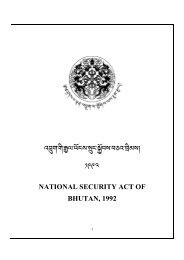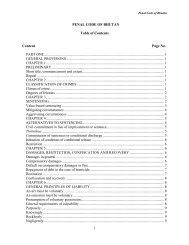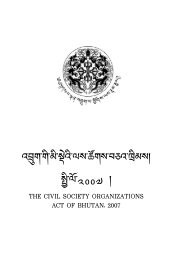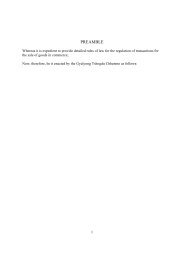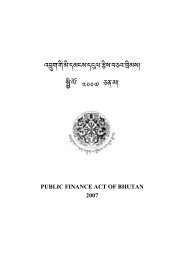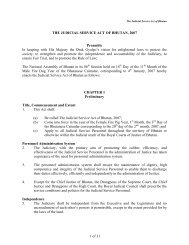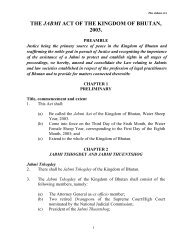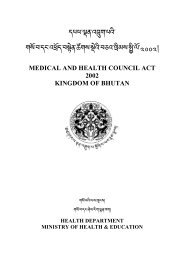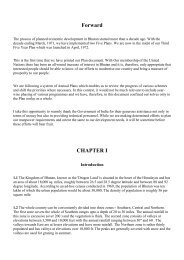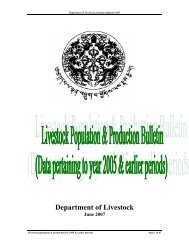journal of renewable natural resources bhutan - Ministry of Agriculture
journal of renewable natural resources bhutan - Ministry of Agriculture
journal of renewable natural resources bhutan - Ministry of Agriculture
- No tags were found...
Create successful ePaper yourself
Turn your PDF publications into a flip-book with our unique Google optimized e-Paper software.
Kelzang Wangchuk et alDiscussionThe results <strong>of</strong> this study represent the nutritional qualities <strong>of</strong> Ficusauriculata trees within the age <strong>of</strong> 15 to 17 years in winter and thelocations within elevations <strong>of</strong> 540 to 1950m asl.There is huge variation in nutritional quality <strong>of</strong> Ficus auriculatabetween different sites. Rajhan (1977) studied the variation in nutritivevalue <strong>of</strong> tree leaves and concluded that nutritive value <strong>of</strong> tree leavesvary with months and season. Thus, a huge variation in nutritivequality between sites can be attributed to the variation in climatic andsoil conditions found at different elevations. This was expectedbecause there are different vegetation zones with different climaticconditions within the elevation range <strong>of</strong> 200 to 2000m asl. Theseattributes <strong>of</strong> Ficus auriculata support the finding <strong>of</strong> Thorne et al.(1999) who indicated that Ficus auriculata populations may haveconsiderable range <strong>of</strong> nutritional parameters such as CP, NDF andADF<strong>of</strong>fering scope for improvement through selection.The study results showed that elevation and rainfall are goodpredictors <strong>of</strong> nutritional quality <strong>of</strong> ficus auriculata. At higherelevations, leaves have lower fiber content and higher CP contentsuggesting that the nutritive quality <strong>of</strong> this tree resource is superior athigher elevation. The inferior nutritional quality at lower elevations isindicated by higher fiber and low CPcontent <strong>of</strong> the leaves.There is wide range <strong>of</strong> nutritive values <strong>of</strong> Ficus auriculata reported inthis study while the nutritive values in published information <strong>of</strong> otherauthors were within a small range. The wide range <strong>of</strong> nutritive values inthis study is attributable to large variations in nutritional qualitiesamong samples from different sites falling under different agroecologicalzones.CONCLUSIONSFicus auriculata is the most important fodder tree within elevation <strong>of</strong>200 to 2000m asl. The nutritive values <strong>of</strong> Ficus auriculata vary withelevations and the amount <strong>of</strong> annual rainfall and the nutritional qualityin terms <strong>of</strong> fiber and CP content is superior at higher elevations.However, this study has not covered soil and management factors8



